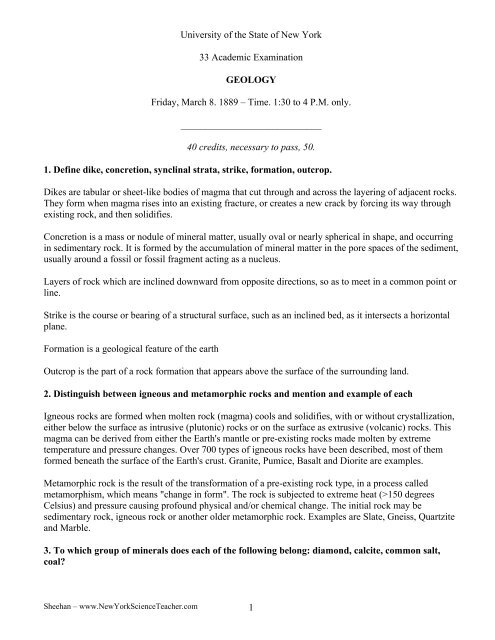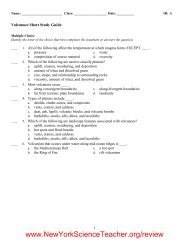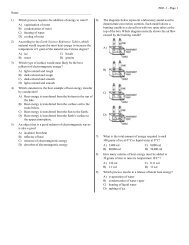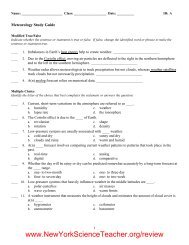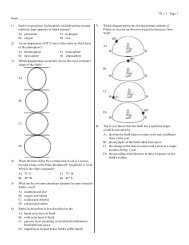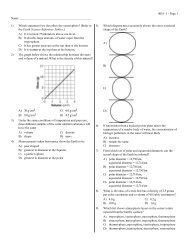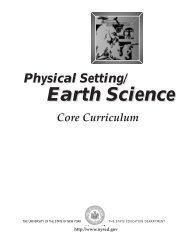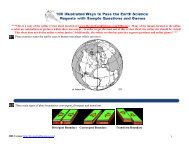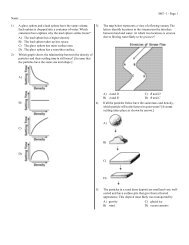Create successful ePaper yourself
Turn your PDF publications into a flip-book with our unique Google optimized e-Paper software.
University of the State of New York33 Academic ExaminationGEOLOGYFriday, March 8. 1889 – Time. 1:30 to 4 P.M. only._____________________________40 credits, necessary to pass, 50.1. Define dike, concretion, synclinal strata, strike, formation, outcrop.Dikes are tabular or sheet-like bodies of magma that cut through and across the layering of adjacent rocks.They form when magma rises into an existing fracture, or creates a new crack by forcing its way throughexisting rock, and then solidifies.Concretion is a mass or nodule of mineral matter, usually oval or nearly spherical in shape, and occurringin sedimentary rock. It is formed by the accumulation of mineral matter in the pore spaces of the sediment,usually around a fossil or fossil fragment acting as a nucleus.Layers of rock which are inclined downward from opposite directions, so as to meet in a common point orline.Strike is the course or bearing of a structural surface, such as an inclined bed, as it intersects a horizontalplane.Formation is a geological feature of the earthOutcrop is the part of a rock formation that appears above the surface of the surrounding land.2. Distinguish between igneous and metamorphic rocks and mention and example of eachIgneous rocks are formed when molten rock (magma) cools and solidifies, with or without crystallization,either below the surface as intrusive (plutonic) rocks or on the surface as extrusive (volcanic) rocks. Thismagma can be derived from either the <strong>Earth</strong>'s mantle or pre-existing rocks made molten by extremetemperature and pressure changes. Over 700 types of igneous rocks have been described, most of themformed beneath the surface of the <strong>Earth</strong>'s crust. Granite, Pumice, Basalt and Diorite are examples.Metamorphic rock is the result of the transformation of a pre-existing rock type, in a process calledmetamorphism, which means "change in form". The rock is subjected to extreme heat (>150 degreesCelsius) and pressure causing profound physical and/or chemical change. The initial rock may besedimentary rock, igneous rock or another older metamorphic rock. Examples are Slate, Gneiss, Quartziteand Marble.3. To which group of minerals does each of the following belong: diamond, calcite, common salt,coal?Sheehan – www.NewYork<strong>Science</strong>Teacher.com 1
4. Mention three kinds of iron oreThe major rock types mined for the production of metallic iron are: massive haematite, pisoliticgoethite/limonite, which provide a "high-grade" ore, and banded metasedimentary ironstone, magnetiterichmetasomatite, to a much lesser degree, rocks rich in siderite, rocks rich in chamosite which provide a"low-grade" ore.5. Describe a geological effect which you have observed in your own neighborhood produced bywater, the wind, alternate freezing and thawingWater: floodingWind: erosion of beach dunesFreezing and Thawing: potholes in the road6. What are fossils mud-cracks and how were they formed?Mud-cracks form when muddy sediment is exposed to the atmosphere and dries up. They have acharacteristic polygonal shape when viewed from above. When viewed from the side, the cracks are “V”-shaped, with the wider part of the “V” toward the surface. Thus, mud-cracks, when preserved in the rockrecord, indicate that the sediment formed in an environment that was alternately wet and dry, like a tidalflat or the flood plain of a river. The distinct "V" shape of the crack in cross-sectional view can indicatewhich way is up.7. Describe the principle of the artesian well and illustrate by a drawing.In an artesian well, water rises from an underground water-containing rock layer under its own pressure.Rain falls at one end of the water-bearing layer, or aquifer, and percolates through the layer. The layer fillswith water up to the level of the water table. Water will flow from a well under its own pressure if the wellhead is below the level of the water table.Sheehan – www.NewYork<strong>Science</strong>Teacher.com 2
8. Upon an outline map of North America indicate the position of the Archean continent9. In what part of New York are Devonian rocks found?The New York border between Pennsylvania and New Jersey is where it begins. It continues upward tojust south of Albany and Syracuse. It encompasses Buffalo, Jamestown, Elmira, Binghamton and Ithaca.For a better visual, see pg. 3 of your ESRT.10. To what age do the Silurian rocks belong? Where are they found in New York State?Range from 418-443 millions of years old.Silurian rocks are found around Niagara Falls and Syracuse. For a better visual, see pg. 3 of your ESRT.11. Mention the formation of coal and name the principal varieties.Coal Formation starts with accumulation of organic matter (bits of dead plants) in a low oxygen settingsuch as a peat bog. The organic matter accumulates and forms a bed of peat. The peat bed gets buried byother sediments and under heat and pressure begins to transform to a low grade coal - a Lignite. More heatand pressure further metamorphose the lignite into Bituminous coal. Even more heat and pressuremetamorphose the bituminous coal into a nice hard shiny Anthracite.11. Mention three kinds of characteristics of the Reptilian ageThe great event of this period was the evolution and decline of the dinosaurs. Land-animal life reached itsgreatest development, in point of size, and had virtually perished from the face of the earth by the end ofthis age. The dinosaurs evolved in all sizes from a species less than two feet long up to the huge noncarnivorousdinosaurs, seventy-five feet long, that have never since been equaled in bulk by any livingcreature.Sheehan – www.NewYork<strong>Science</strong>Teacher.com 3


